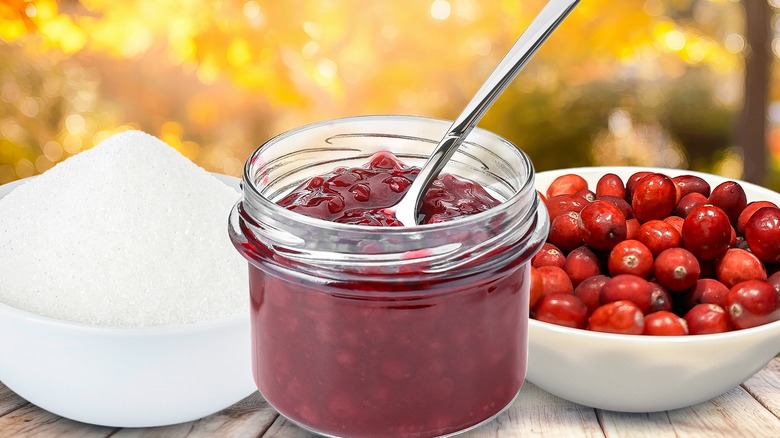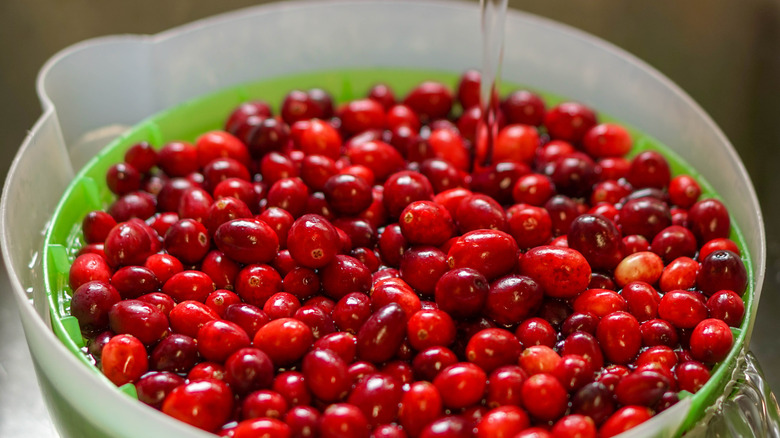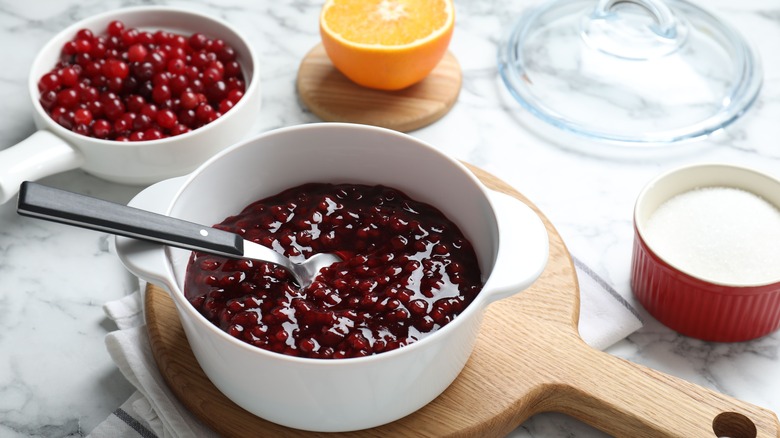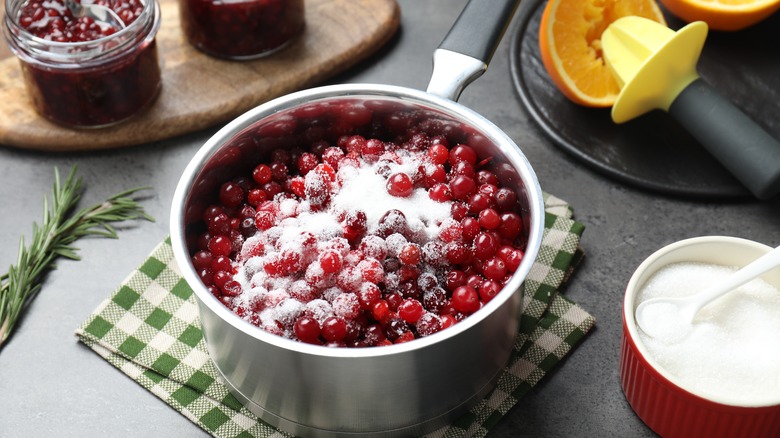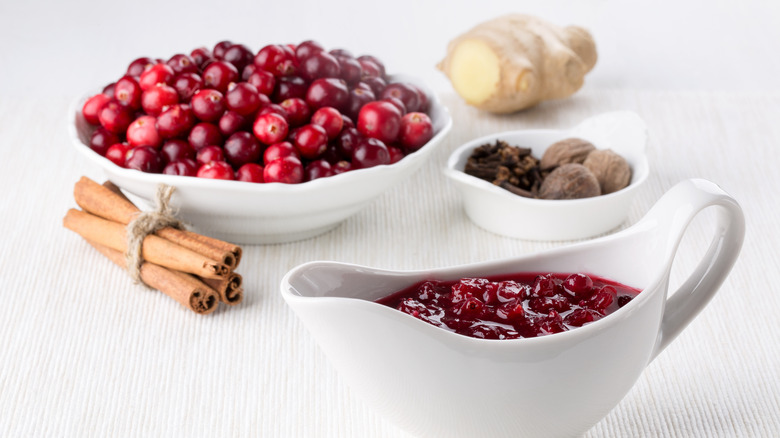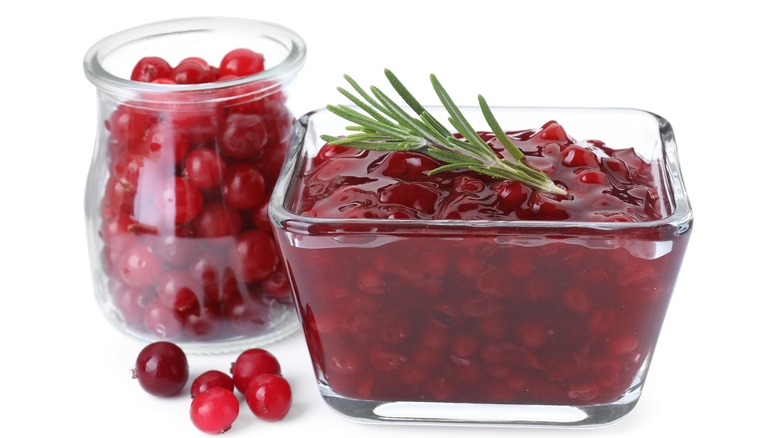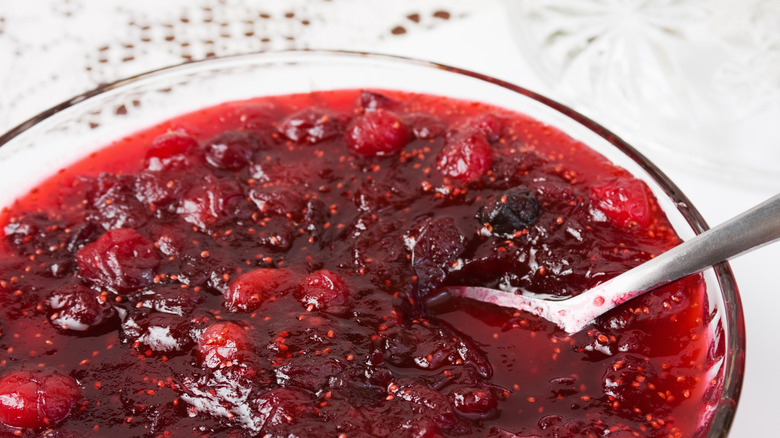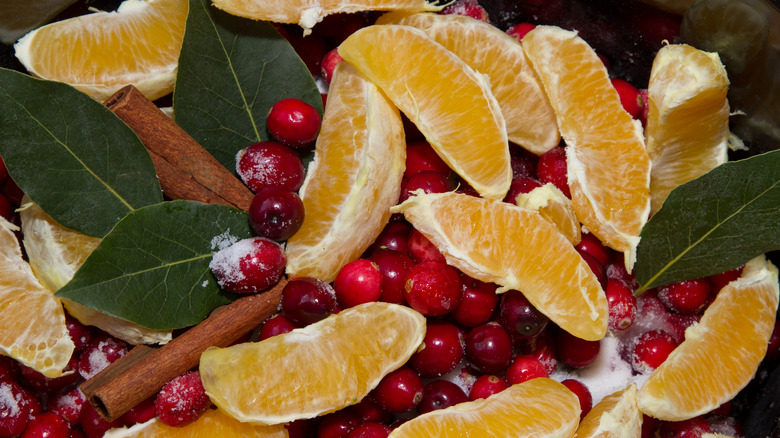9 Common Mistakes Everyone Makes With Cranberry Sauce
No Thanksgiving table is complete without cranberry sauce. It's a beloved side dish that has become as much a part of the American tradition as the turkey. In fact, Americans eat five million gallons of it each holiday season. It's a tart and tangy counterpart to the richness of all of the traditional Thanksgiving dishes. Serving canned cranberry sauce might be the easier route — more than 75% of Americans purchase it — but homemade cranberry sauce is another level of deliciousness. Making it from scratch allows you to tweak the flavors to create a sauce that suits your family's tastes. Whether you prefer your sauce on the sweet side or enjoy a more savory cranberry sauce, you can easily simmer up a batch that everyone at your table will love.
As a personal chef, preparing holiday meals for my clients was par for the course. I'd spend the days before Thanksgiving in their kitchens cooking everything from the turkey to the sides, including the cranberry sauce. Homemade cranberry sauce was a game changer for many of my clients who were only accustomed to the jellied canned variety. As much as we love the nostalgia those store bought cans hold for many of us, a homemade sauce will make you want to kick the cans to the curb forever. Cranberry sauce from scratch is simple. These tips will help you avoid these common mistakes everyone makes when making it.
Not checking your berries
The outcome of a recipe is sometimes determined by a simple step that occurs before you even start to cook. That step is choosing the best ingredients. Starting with the highest quality ingredients that are ripe and in great condition will give you the most delicious results. For the best tasting cranberry sauce, use only the best cranberries.
You can use both fresh and frozen cranberries to make sauce. If you go the frozen route, you don't worry about thawing them before you cook. You can use them straight from the freezer. Don't be tempted to pour your cranberries straight from the bag into a pot. It's imperative that you take a few minutes and check the berries to make sure they're in perfect condition. Rinse the berries, then pick through them. Cranberries that are firm and smooth will deliver the bright, tangy flavor that cranberry sauce is known for. Sorting through the cranberries allows you to toss any that are wrinkled, soft to touch, or that are burst. Damaged or spoiled berries can give your sauce an unpleasant bitterness or off-flavor.
Getting the quantity wrong
Whether you're a home cook or catering a meal for a crowd, making sure you have enough of each dish to serve everyone is key to the success of the entire meal. That's especially true for holiday meals when the goal is often to have not only enough for the big dinner, but also just enough for leftovers. When I cooked for clients, I pored over recipes and formulas meant to help cooks determine how much to cook for how many. Even with that support, I still worried about imaginary guests who piled their plates high, leaving nothing behind for other diners. That, thankfully, never happened, but the concern was always there even when I cooked for friends and family at home. You want to get the quantity right, so everyone's satisfied and there's still a bit left for a few post-Thanksgiving meals, but not so much you end up tossing it.
Based on a quarter-cup serving size, cranberry sauce made from one 12-ounce bag of cranberries should produce enough sauce to serve about 10 people. This will vary slightly depending on how much of the other ingredients, especially liquids, you add to your sauce. If you're cooking for a table full of cranberry sauce lovers or want leftovers, double the amount and aim for half-cup servings.
Relying only on white sugar to sweeten it
Cranberries are known for their tart, slightly bitter taste. Most cooks rely on white granulated sugar to sweeten them, especially when they're making cranberry sauce. Sugar helps soften the bitterness, creating a balanced flavor, but it's not the only option. Other sweeteners can not only sweeten your sauce, but can also give it a more complex, nuanced flavor.
Honey is another choice to consider for sweetening cranberry sauce and depending on the variety it can also add floral or citrus flavors. Maple syrup is another option. It will give your sauce warm, earthy notes. Brown sugar and or coconut sugar will add a molasses taste to your sauce. Experiment with different sweeteners so you can customize the sauce to your liking.
If your sauce is too sweet, you can temper the sweetness by adding a splash of acid to your cranberry sauce. Any citrus juice or mild vinegar will counteract the excess sweetness. You can also add a pinch of salt to cut the sugar.
Not adding fresh ginger
If you're looking to personalize your homemade cranberry sauce with a twist that sets it apart from others, consider adding fresh ginger into the mix. Fresh ginger will add a zesty, slightly spicy kick to cranberry sauce, which is a delicious contrast to the berries' natural tartness. It has a rich aroma and pleasantly pungent taste that will perk up your cranberry sauce and your tastebuds.
Ginger is wrapped in a thin, papery skin. To peel ginger, use a spoon to strip away the skin away before putting it to use. Be sure to finely grate the ginger before adding it to the cranberry sauce. Larger pieces of ginger will add bold pungency, but are unpleasant to chew. Ginger has a big flavor so add a little at a time, to taste.
If you don't have fresh ginger on hand, but still want to add a subtle ginger flavor, add a pinch or two of ground ginger instead. It will add a warm, piquant edge to your cranberry sauce. Dried ginger has a more concentrated flavor than fresh, so you can't substitute powdered and fresh ginger in measure for measure. Use ¼ teaspoon of ground ginger for every teaspoon of fresh ginger your recipe calls for.
Making it on Thanksgiving day
Skip the Thanksgiving day last minute rush and make your cranberry sauce ahead of time. Unlike many of the traditional holiday recipes, cranberry sauce doesn't taste its best immediately after it's cooked. The flavors in cranberry sauce are best enjoyed after the sauce has had an opportunity to cool completely. It will take about two hours for your sauce to cool down. Prepping it ahead of time means you don't have to factor the cooling time into your Thanksgiving day timetable. You'll also skip the last minute rush when so many dishes are competing for space on the stovetop.
Whether I was making cranberry sauce for clients or simmering a batch for my family's holiday spread, making the sauce before the big day allowed me to check one more thing off my day-of to-do list. Thankfully, homemade cranberry sauce is built for this type of holiday meal prep. It will last for 10 to 14 days in the fridge so you can safely prepare and store it long before turkey day. You'll also get the benefit of fuller, more developed flavors if you get your sauce done early. If you've added spices to your sauce they will intensify the longer they're allowed to sit.
Getting the consistency wrong
The ideal cranberry sauce is a delicious mix of thickness and spreadability, but it's easy to get it wrong when you're making it from scratch. A thin sauce will create a puddle on your plate and an overly thick sauce will be dense and unappetizing. The goal is cranberry sauce that is thick enough to hold its shape, but still soft enough to spoon easily.
Cranberries contain pectin, a natural thickener found in some fruits and vegetables. It's activated when the cranberries are heated and the berries burst. Pectin needs to come to a complete boil in order to work, so make sure to heat your sauce until it boils. Take your sauce off the heat before it reaches your ideal thickness. While this may seem like the opposite of what you should do for perfect sauce, it's important to keep in mind that the sauce will continue to thicken as it cools. Resist the temptation to cool your sauce quickly by immediately taking it from the stovetop to the fridge. This can prevent your sauce from thickening or gelling properly.
If your sauce is too thick, you can always stir in a splash of water or a flavorful liquid like orange juice, to thin it out. Thin sauces can be thickened by putting them back on the stove and cooking them longer.
Making it exclusively on the stovetop
There's nothing better for cooks in charge of Thanksgiving dinner than a dish that doesn't require a lot of fuss or attention, like homemade cranberry sauce. Preparing it on the stovetop might be the traditional way to make it, but making it in a slow cooker is a game changer. You can save valuable stovetop real estate and free your hands and attention up for other tasks. Slow cooker cranberry sauce takes longer, about three to four hours, but you'll get the added benefit of fuller flavor that comes with the longer cooking time.
Slow cookers cook food by locking in the moisture that builds up as the food cooks. This can be problematic when making cranberry sauce because the moisture will prevent the sauce from thickening. You can prevent this by letting the sauce slow cook for an hour and a half, then adjusting the lid on the slow cooker so that there's a one to two-inch opening. This will allow moisture to escape so the sauce can thicken.
Neglecting to add booze
Perfect cranberry sauce is all about a delicate balance of flavors. The sweet, the tart, and the savory blend together to create a delicious flavorful experience. One ingredient can amp up the taste of your homemade cranberry sauce and you might already have it on your bar cart. You can give your cranberry sauce a sophisticated twist by adding a splash of booze.
Alcohol is used frequently in cooking to add the depth and complexity of the alcohol's flavor to your dish, and that's exactly what it does when it's added to homemade cranberry sauce. Choose a spirit like bourbon, rum or gin for warm, rich notes that complement the tartness of the cranberries and pair well with the sweetness from the sugar or other sweeteners you've added.
A little alcohol goes a long way so you don't need to add much to impart the perfect amount of flavor. A good rule of thumb is to add half a tablespoon of alcohol for every cup of finished sauce your recipe makes to start. If your recipe makes 2 cups of finished cranberry sauce, you'll only need to add 1 tablespoon to the entire batch. That's just enough to boost flavor without the alcohol overpowering the other flavors. You can add more, to taste, if necessary.
Only serving it as a Thanksgiving side
Cranberry sauce is known for its place as a mandatory side dish on Thanksgiving tables, but homemade cranberry sauce is more than just turkey's favorite sidepiece. It's far more versatile than the traditional way we've all grown accustomed to. Think outside the can and you'll find homemade cranberry sauce has many delicious uses that can extend its usage in your kitchen.
Its sweet-tart flavor pairs perfectly with the buttery richness of Brie cheese. Tuck them into puff pastry cups along with rosemary, and garlic for cranberry brie bites, a crowd-pleasing appetizer you can whip up in minutes. Meatball lovers can turn regular meatballs into cranberry meatballs by using warmed cranberry sauce as a meatball glaze. Cocktail hour can also benefit from cranberry sauce. Blend cranberry sauce with vodka, Cointreau, and lime juice for a crisp, refreshing cranberry sauce frozen cosmo.
You don't need a recipe to use cranberry sauce. I've used it as a sandwich spread, as a tasty topper for yogurt parfaits, and as an accompaniment to cheeses on cheese and charcuterie boards. With so many uses, homemade cranberry sauce becomes a versatile ingredient that can elevate a variety of dishes, not just during the holiday season, but throughout the year.
